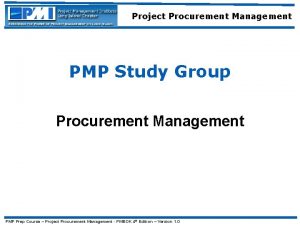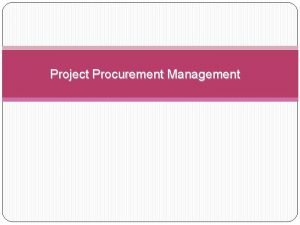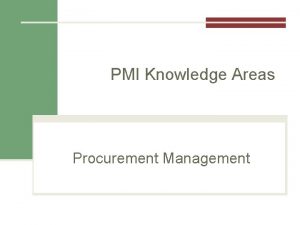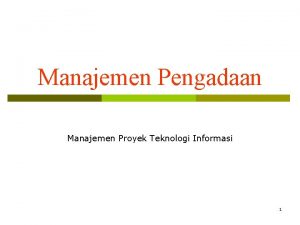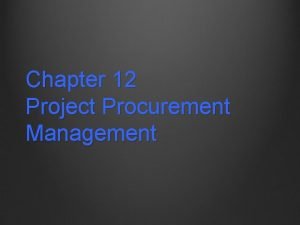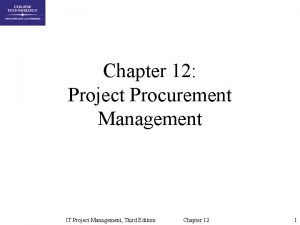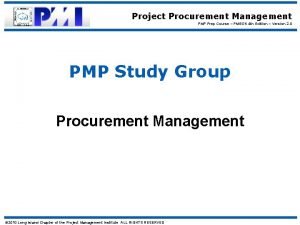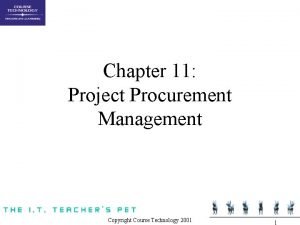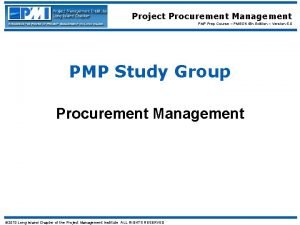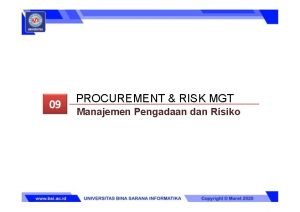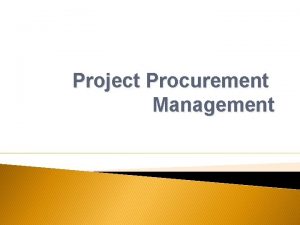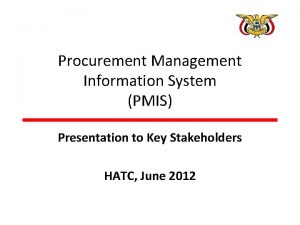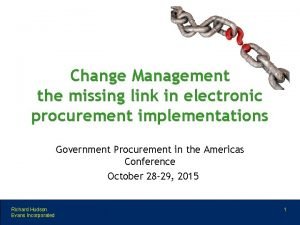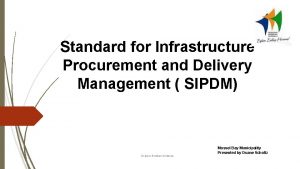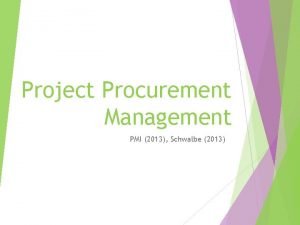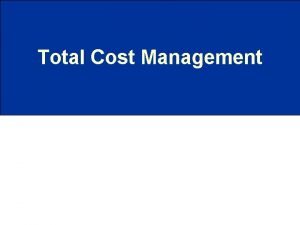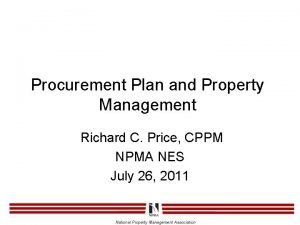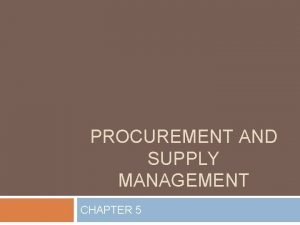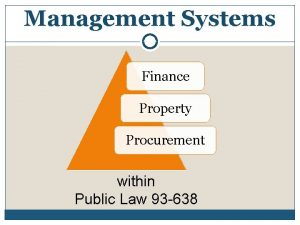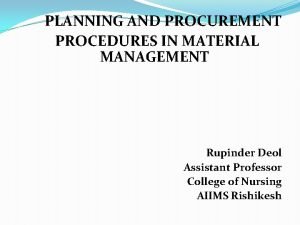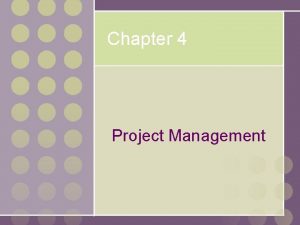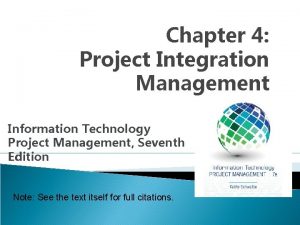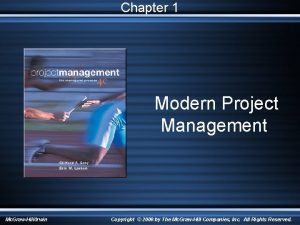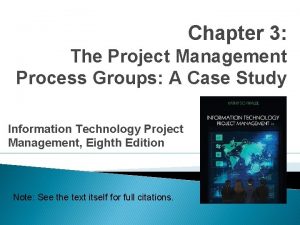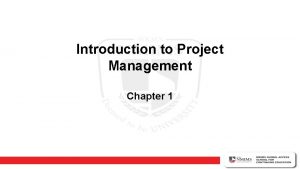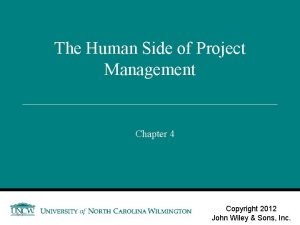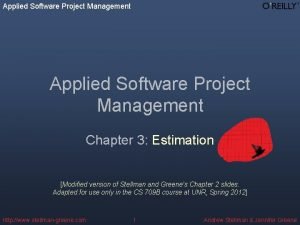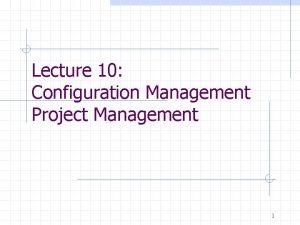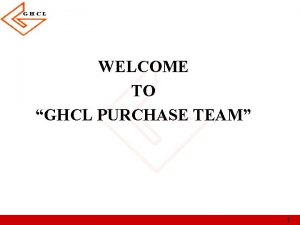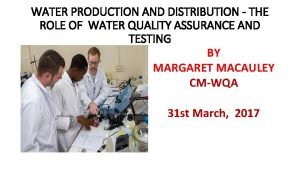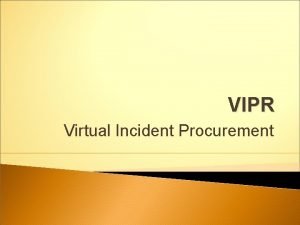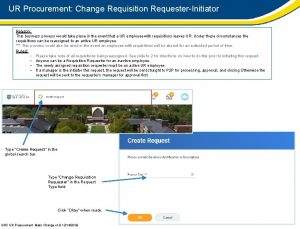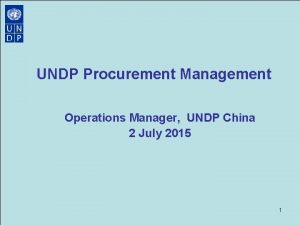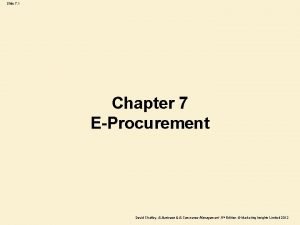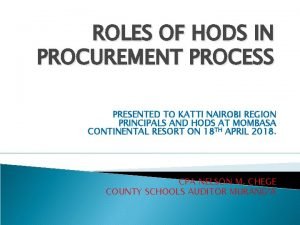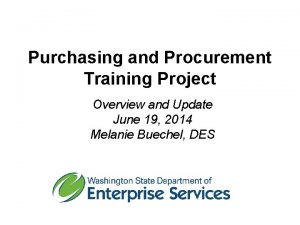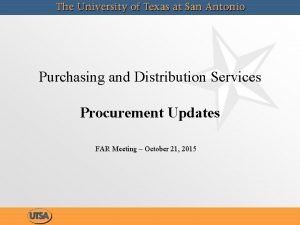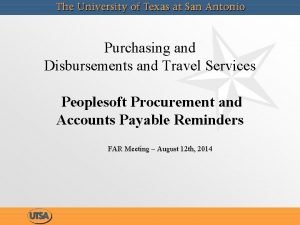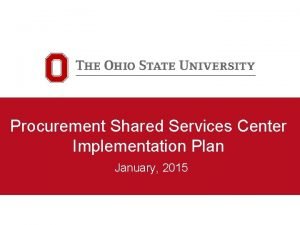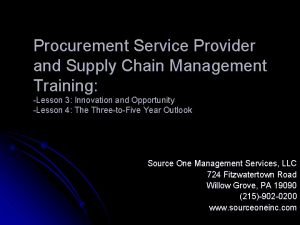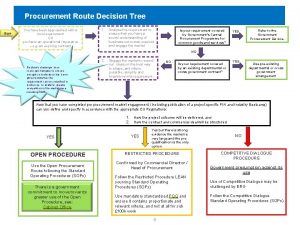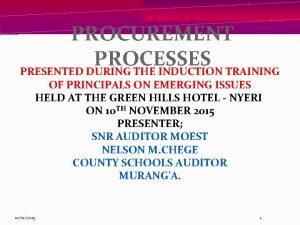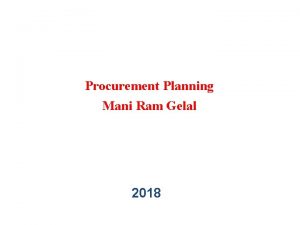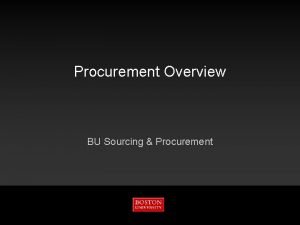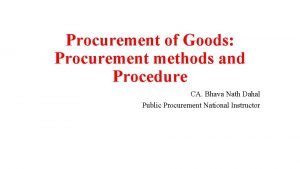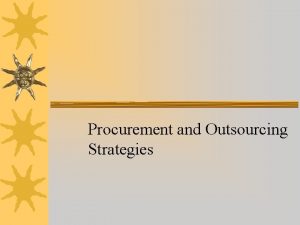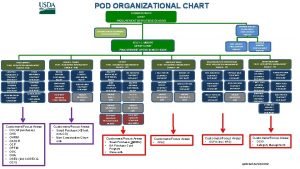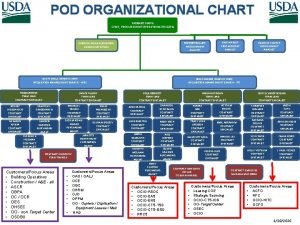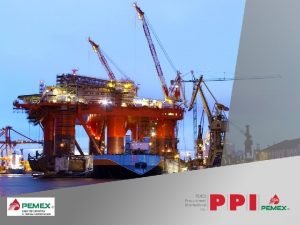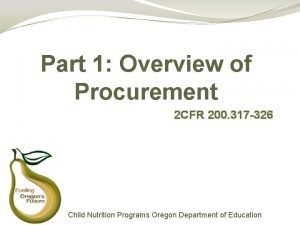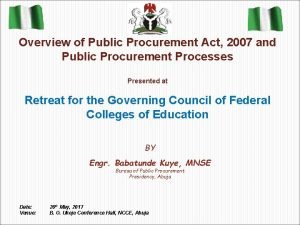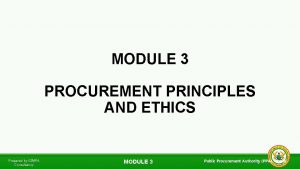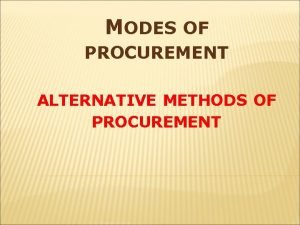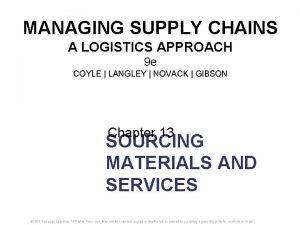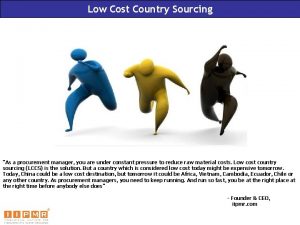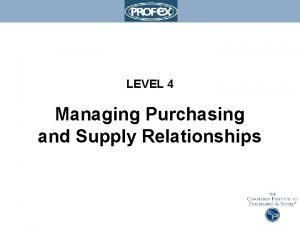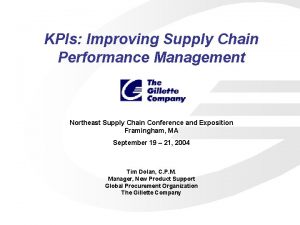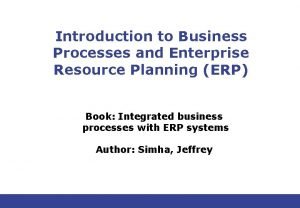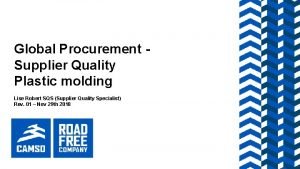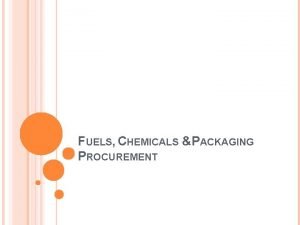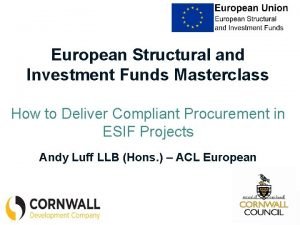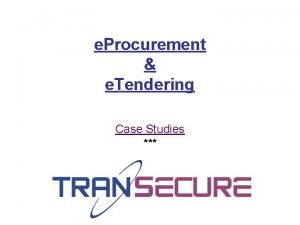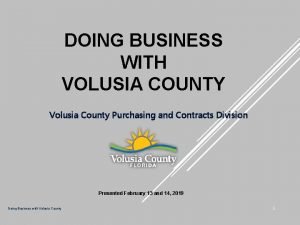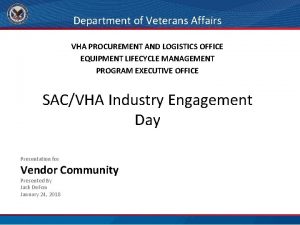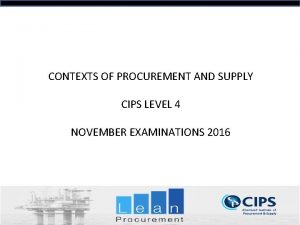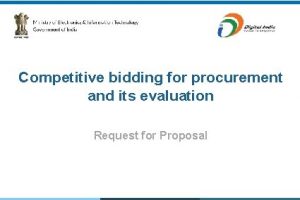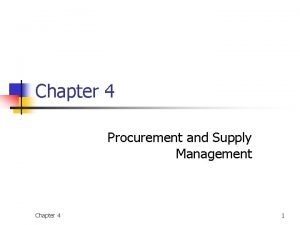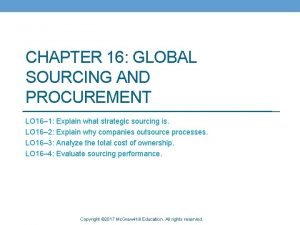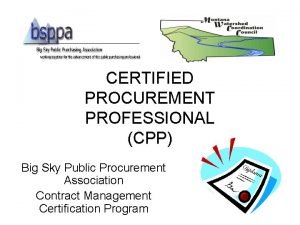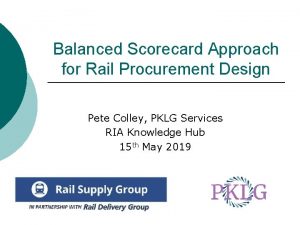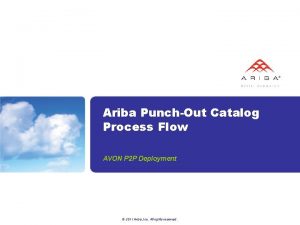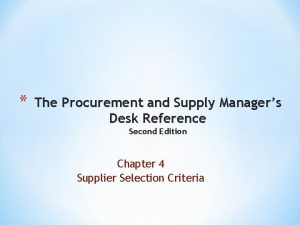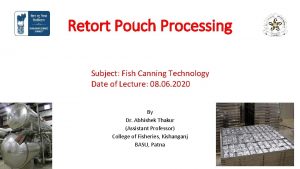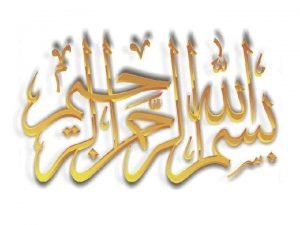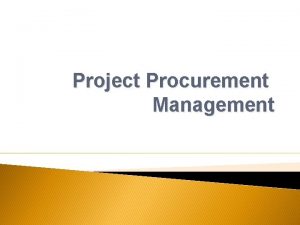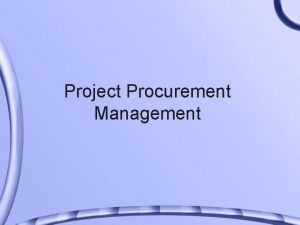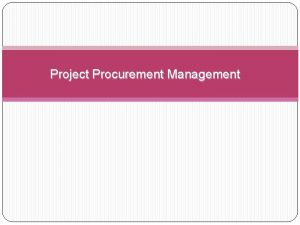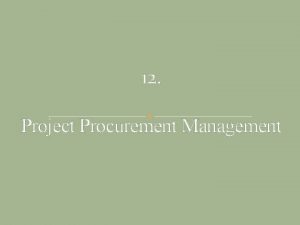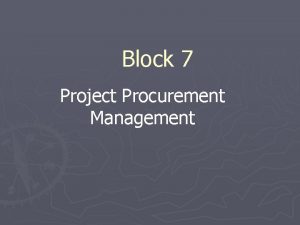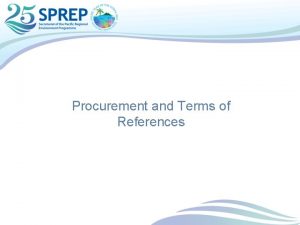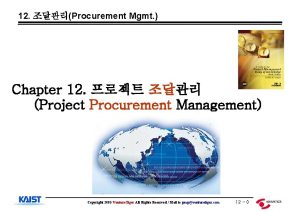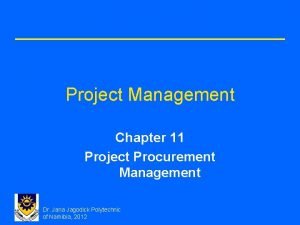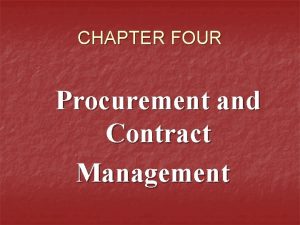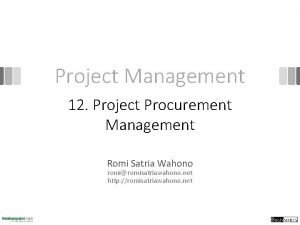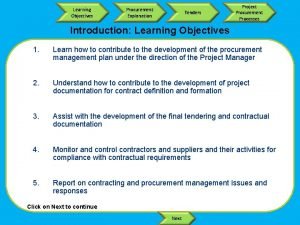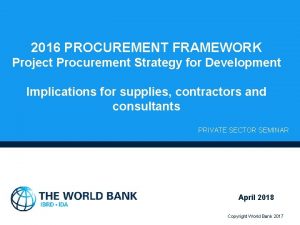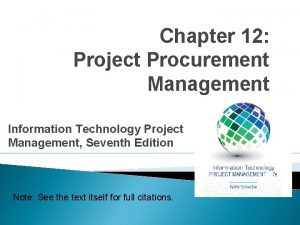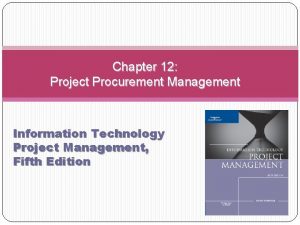Chapter 12 Project Procurement Management Project Procurement Management








































































































- Slides: 104

Chapter 12 Project Procurement Management

Project Procurement Management includes the processes necessary to purchase or acquire products, services, or results needed from outside the project team. It also includes the management and control processes required to develop and administer agreements.

The Project Procurement Management processes are: 12. 1 Plan Procurement Management 12. 2 Conduct Procurements 12. 3 Control Procurements

Figure 12 -1

Key Concepts for Project Procurement Management There can be significant legal obligations and penalties tied to the procurement process. The Project Procurement Management processes involve agreements that describe the relationship between two parties – a buyer and a seller.

Agreements can be as simple as the purchase of a defined quantity of labor hours at a specified labor rate or they can be as complex as multiyear international construction contracts. Most organizations document policies and procedures specifically defining procurement rules and specifying who has authority to sign and administer such agreements on behalf of the organization.

The winning bidder may manage the work as a project. In such cases: § The buyer becomes the customer to subcontractor, suppliers, and service providers and is there fore a key project stakeholder from the seller’s perspective § The seller’s project management team may be concerned with all the processes involved in performing the work or providing the services

§ Terms and conditions of the contract and the procurement statement of work (SOW) become key inputs to many of the seller’s management processes. The contract can actually contain the inputs or it can limit the project team’s options. The procurement SOW may have other names, such as the technical statement of work § The seller itself may become a buyer of lowertiered products, services, and materials from subcontractors and suppliers

Trends and Emerging Practices In Procurement Management § Advances in tools § More advanced risk management § Changing contracting processes § Logistics and supply chain management § Technology and stakeholder relations § Trial engagements

Tailoring Considerations § Complexity of procurement § Physical location § Governance and regulatory environment § Availability of contractors

Considerations For Agile/Adaptive Environments In agile environments, specific sellers may be used to extend the team. Larger projects may use an adaptive approach for some deliverables and a more stable approach for other parts.

12. 1 Plan Procurement Management is the process of documenting project procurement decisions, specifying the approach and identifying potential sellers. The key benefit of this process is that it determines whether to acquire goods and services from outside the project and, if so, what to acquire as well as how and when to acquire it.

Figure 12 -2

Figure 12 -3

Typical steps in documenting the procurement management plan: § Prepare the procurement statement of work (SOW) or terms of reference (TOR) § Prepare a high-level cost estimate to determine the budget § Advertise the opportunity § Identify a short list of qualified sellers § Prepare and issue bid documents

§ Prepare and submit proposals by the seller § Conduct a technical evaluation of the proposals including quality § Perform a cost evaluation of the proposals § Prepare the final combined quality and cost evaluation to select the winning proposal § Finalize negotiations and sign contract between the buyer and the seller

12. 1. 1 Plan Procurement Management: Inputs 12. 1. 1. 1 Project Charter The project charter contains the objectives, project description, summary milestones, and the preapproved financial resources.

12. 1. 1. 2 Business Documents § Business case § Benefits management plan

12. 1. 1. 3 Project Management Plan § Scope management plan § Quality management plan § Resource management plan § Scope baseline

12. 1. 1. 4 Project Documents § Milestone list § Project team assignments § Requirements documentation § Technical requirements that the seller is required to satisfy § Requirements with contractual and legal implications that may include health, safety, security, performance, environmental, insurance, intellectual property rights, equal employment opportunity, licenses, permits and other nontechnical requirements

§ Requirements traceability matrix § Resource requirements § Risk register § Stakeholder register

12. 1. 1. 5 Enterprise Environmental Factors § Marketplace conditions § Products, services, and results that are available in the marketplace § Sellers, including their past performance or reputation § Typical terms and conditions for products, services, and results or for the specific industry § Unique local requirements, such as regulatory requirements for local labor or sellers

§ Legal advice regarding procurements § Contract management systems, including procedures for contract change control § Established multi-tier supplier system of prequalified sellers based on prior experience § Financial accounting and contract payments system

12. 1. 1. 6 Organizational Process Assets The various types of contractual agreements used by the organization also influence decisions for the Plan Procurement Management process. The organizational process that can influence this is are: § Preapproved seller lists § Formal procurement policies, procedures, and guidelines

§ Contract types: § Fixed price contracts Firm fixed price (FFP) Fixed price incentive fee (FPIF) Fixed price with economic price adjustments (FPEPA) § Cost-reimbursable contracts § Cost plus fixed fee (CPFF) § Cost plus incentive fee (CPIF) § Cost plus award fee (CPAW) § Time and material contracts (T&M)

12. 1. 2 Plan Procurement Management: Tools and Techniques 12. 1 Expert Judgment Expertise should be considered from individuals or groups with specialized knowledge or training in the following topics: § Procurement and purchasing § Contract types and contract documents § Regulations and compliance topics

12. 1. 2. 2 Data Gathering A data-gathering technique that can be used for this process include market research. Market research included examination of industry and specific seller capabilities.

12. 1. 2. 3 Data Analysis Data analysis techniques that can be used for this process include make-or-buy analysis. A make-or-buy analysis is used to determine whether work or deliverables can best be accomplished by the project team or should be purchased from outside sources. Make-or-buy analysis may use payback period, return on investment (ROI), internal rate of return (IRR), discounted cash flow, net present value (NPV), benefit/cost analysis (BCA) or other techniques.

12. 1. 2. 4 Source Selection Analysis Since competitive selection methods may require sellers to invest a large amount of time and resources upfront, it’s a good practice to include the evaluation method in the procurement documents so bidders know how they will be evaluated. Commonly used selection methods include: § Least cost § Qualifications only

§ Quality-based/highest technical proposal score § Quality and cost-based § Sole source § Fixed budget

12. 1. 2. 5 Meetings Research alone may not provide specific information to formulate a procurement strategy without additional information interchange meetings with potential bidders. Meetings can be used to determine the strategy for managing and monitoring the procurement.

12. 1. 3 Plan Procurement Management: Outputs 12. 1. 3. 1 Procurement Management Plan The procurement management plan contains the activities to be undertaken during the procurement process. It should document whether international competitive bidding, local bidding, should be done.

The procurement management plan can include guidance for: § How procurement will be coordinated with other project aspects, such as project schedule development and control processes § Timetable of key procurement activities § Procurement metrics to be used to manage contracts § Stakeholder roles and responsibilities related to procurement, including authority and constraints of the project team when the performing organization has a procurement department

§ Constraints and assumptions that could affect planned procurements § The legal jurisdiction and the currency in which payments will be made § Determination of whether independent estimates will be used and whether they are needed as evaluation criteria § Risk management issues including identifying requirements for performance bonds or insurance contracts to mitigate some forms of project risk § Prequalified sellers, if any, to be used

12. 1. 3. 2 Procurement Strategy A procurement strategy should be identified once the make-or-buy analysis is complete and the decision is made to acquire from outside the project. The objective of the procurement strategy is to determine the project delivery method, the type of legally binding agreement(s), and how the procurement will advance through the procurement phases.

§ Delivery methods § For professional services, delivery methods include: buyer/services provider with no subcontracting, buyer/services provider with subcontracting allowed, joint venture between buyer and services provider, and buyer/services provider acts as the representative § For industrial or commercial construction, project delivery methods include but are not limited to: turnkey, design build (DB), design bid build (DBB), design build operate (DBO), build own operate transfer (BOOT), and others

§ Contract payment types § Fixed-price contracts are suitable when the type of work is predictable and the requirements are well defined and not likely to change § Cost plus contracts are suitable when the work is evolving, likely to change, or not well defined § Incentives and awards may be used to align the objectives of buyer and seller

§ Procurement phases § Sequencing of phasing of the procurement, a description of each phase and the specific objectives of each phase § Procurement performance indicators and milestones to be used in monitoring § Criteria for moving from phase to phase § Monitoring and evaluation plan for tracking progress § Process for knowledge transfer for use in subsequent phases

12. 1. 3. 3 Bid Documents Bid documents are used to solicit proposals from prospective sellers. Depending on the goods or services needed, the bidding documents can include: § Request for information (RFI) § Request for quotation (RFQ) § Request for proposal (RFP)

12. 1. 3. 4 Procurement Statement of Work The statement of work (SOW) for each procurement is developed from the project scope baseline and defines only that portion of the project scope that is to be included within the related contract. It describes the procurement item in sufficient detail to allow prospective sellers to determine if they are capable of providing the products, services, or results.

The phrase terms of reference (TDR) is sometimes used when contracting for services. Similar to the procurement SOW, a TDR typically includes these elements: § Tasks the contractor is required to perform as well as specified coordination requirements § Standards the contractor will fulfill that are applicable to the project § Data that needs to be submitted for approval § Detailed list of all data and services that will be provided to the contractor by the buyer for use in performing the contract, if applicable § Definition of the schedule for initial submission and the review/approval time required

12. 1. 3. 5 Source Selection Criteria In choosing evaluation criteria, the buyer seeks to ensure that the proposal selected will offer the best quality for the services required. The source selection criteria may include: § Capability and capacity § Product cost and life cycle cost § Delivery dates § Technical expertise and approach

§ Specific relevant experience § Adequacy of the proposed approach and work plan in responding to the SOW § Key staff’s qualifications, availability, and competence § Financial stability of the firm § Management experience § Suitability of the knowledge transfer program, including training

12. 1. 3. 6 Make-Or-Buy Decisions A make-or-buy analysis results in a decision as to whether particular work can best be accomplished by the project team or needs to be purchased from outside sources.

12. 1. 3. 7 Independent Cost Estimates For large procurements, the procuring organization may elect to either prepare its own independent estimate or have a cost estimate prepared by an outside professional estimator to serve as a benchmark on proposed responses.

12. 1. 3. 8 Change Requests A decision that involves procuring goods, services, or resources may require a change request. Other decisions during procurement planning can also create the need for additional change requests. Change requests are processed for review and disposition through the Perform Integrated Change Control process.

12. 1. 3. 9 Project Documents Updates Project documents that may be updated as a result of carrying out this process include: § Lessons learned register § Milestone list § Requirements documentation § Technical requirements that the seller is required to satisfy § Requirements with contractual and legal implications that may include health, safety, security, performance, environmental, insurance, intellectual property rights, equal employment opportunity, licenses, permits and other nontechnical requirements

§ Requirements traceability matrix § Risk register § Stakeholder register

12. 1. 3. 10 Organizational Process Assets Updates Organizational process assets that are updated as a result of the Plan Procurement Management process include information on qualified sellers. For projects with few procurements and relatively simple procurements, some of these outputs may be combined.

Table 12 -1

12. 2 Conduct Procurements is the process of obtaining seller responses, selecting a seller, and awarding a contract. The key benefit of this process is that it selects a qualified seller and implements the legal agreement of delivery.

Figure 12 -4

Figure 12 -5

12. 2. 1 Conduct Procurements: Inputs 12. 2. 1. 1 Project Management Plan Project management plan components: § Scope management plan § Requirement management plan § Communications management plan § Risk management plan § Procurement management plan § Configuration management plan § Cost baseline

12. 2. 1. 2 Project Documents Project documents that can be considered as inputs: § Lessons learned register § Project schedule § Requirements documentation § Technical requirements the seller is required to satisfy § Requirements with contractual and legal implications that may include health, safety, security, performance, environmental, insurance, intellectual property rights, equal employment opportunity, licenses, permits and other

§ Risk register § Stakeholder register

12. 2. 1. 3 Procurement Documentation Procurement documentation provides a written record used in reaching the legal agreement, and may include older documents predating the current project. Procurement documentation include: § Bid documents § Procurement statement of work § Independent cost estimates § Source selection criteria

12. 2. 1. 4 Seller Proposals Seller proposals form the basic information that will be used by an evaluation body to select one or more successful bidders (sellers).

12. 2. 1. 5 Enterprise Environmental Factors The enterprise environmental factors that can influence the Conduct Procurements Process include: § Local laws and regulations regarding procurements § Local laws and regulations ensuring that the major procurements involve local sellers § External economic environment constraining procurement processes

§ Marketplace conditions § Information on relevant past experience with sellers, both good and bad § Prior agreements already in place § Contract management systems

12. 2. 1. 6 Organizational Process Assets The organizational process assets that can influence the Conduct Procurement process include: § List of preferred sellers that have been prequalified § Organizational policies that influence the selection of a seller § Specific organizational templates or guidelines that will determine the way agreements are drafted and built § Financial policies and procedures regarding

12. 2. 2 Conduct Procurements: Tools and Techniques 12. 2. 2. 1 Expert Judgment Expertise should be considered from individuals or groups with specialized knowledge or training in the following topics: § Proposal evaluation § Technical or subject matter § Relevant functional areas such as finance, engineering, design, development, supply chain management

§ Industry regulatory environment § Laws, regulations, and compliance requirements § Negotiation

12. 2 Advertising is communicating with users or potential users of a product, service, or result. Most government jurisdictions require public advertising or online posting of pending government contracts.

12. 2. 2. 3 Bidder Conferences Bidder conferences are meetings between the buyer and prospective sellers prior to proposal submittal. They are used to ensure that all prospective bidders have a clear and common understanding of the procurement and no bidders receive preferential treatment.

12. 2. 2. 4 Data Analysis A data analysis technique that can be used for this process is evaluation. Proposals are evaluated to ensure they are complete and respond in full to the bid documents, procurement statement of work, source selection criteria and any other documents that went out in the bid package.

12. 2. 2. 5 Interpersonal and Team Skills Interpersonal and team skills that can be used for this process include negotiation. Negotiation is a discussion aimed at reaching an agreement. Negotiation concludes with a signed contract document or other formal agreement that can be executed by both buyer and seller. The negotiation should be led by a member of the procurement team that can sign contracts.

12. 2. 3 Conduct Procurements: Outputs 12. 2. 3. 1 Selected Sellers The selected sellers are those who have been judged to be a competitive range based on the outcome of the proposal or bid evaluation.

12. 2. 3. 2 Agreements A contract is a mutually binding agreement that obligated the seller to provide the specified products, services, or results; obligates the buyer to compensate the seller, and represents a legal relationship that is subject to remedy in the courts.

The major components in an agreement document may include: § Procurement statement of work or major deliverables § Schedule, milestones, or date by which a schedule is required § Performance reporting § Pricing and payment terms § Inspection, quality and acceptance criteria

§ Warranty and future product support § Incentives and penalties § Insurance and performance bonds § Subordinate subcontractor approvals § General terms and conditions § Change request handling § Termination clause and alternative dispute resolution mechanisms

12. 2. 3. 3 Change Requests Change requests to the project management plan, its subsidiary plans, and other components are processed for review and disposition through the Perform Integrated Change Control process.

12. 2. 3. 4 Project Management Plan Updates Any change to the project management plan goes through the organization’s change control process via a change request. Components of the project management plan that may require a change request for the project management plan include: § Requirements management plan § Quality management plan § Communications management plan

§ Risk management plan § Procurement management plan § Scope baseline § Schedule baseline § Cost baseline

12. 2. 3. 5 Project Documents Updates Project documents that may be updated as a result of carrying out this process include: § Lessons learned register § Requirements documentation § Technical requirements that the seller is required to satisfy § Requirements with contractual and legal implications that may include health, safety, security, performance, environmental, insurance, intellectual property rights, equal employment opportunity, licenses, permits and other nontechnical requirements

§ Requirements traceability matrix § Resource calendars § Risk register § Stakeholder register

12. 2. 3. 6 Organizational Process Assets Updates Elements of the organizational process assets that can be updated as a result of the Conduct Procurements process include: § Listings of prospective and prequalified sellers § Information on relevant experience with sellers, both good and bad

12. 3 Control Procurements is the process of managing procurement relationships; monitoring contract performance, and making changes and corrections as appropriate; and closing out contracts. The key benefit of this process is that it ensures that both the seller’s and buyer’s performance meet the project’s requirements according to the terms of the legal agreement.

Figure 12 -6

Figure 12 -7

Control Procurements includes application of the appropriate project management processes to the contractual relationship(s) and integration of the outputs from these processes into the overall management of the project. This integration often occurs at multiple levels when there are multiple sellers and multiple products, services, or results involved.

Administrative activities include: § Collection of data and managing project records, including maintenance of detailed records of physical and financial performance and establishment of measurable procurement performance indicators § Refinement of procurement plans and schedules § Set up for gathering, analyzing, and reporting procurement-related project data and preparation of periodic reports of the organization § Monitoring the procurement environment so that implementation can be facilitated or adjustments made § Payment of invoices

Control Procurements has a financial management component that involves monitoring payments to the seller. This ensures that payment terms defined within the contract are met and that compensation is linked to the seller’s progress as defined in the contract.

12. 3. 1 Control Procurements: Inputs 12. 3. 1. 1 Project Management Plan Project management plan components include: § Requirements management plan § Risk management plan § Procurement management plan § Change management plan § Schedule baseline

12. 3. 1. 2 Project Documents Project documents that can be considered as inputs to this process include: § Assumption log § Lessons learned register § Milestone list § Quality reports

§ Requirements documentation § Technical requirements the seller is required to satisfy § Requirements with contractual and legal implications that may include health, safety, security, performance, environmental, insurance, intellectual property rights, equal employment opportunity, licenses, permits and other nontechnical requirements § Requirements traceability matrix § Risk register § Stakeholder register

12. 3. 1. 3 Agreements are understandings between parties, including understanding of the duties of each party.

12. 3. 1. 4 Procurement Documentation Procurement documentation contains complete supporting records for administration of the procurement processes. This includes the statement of work, payment information, contractor work performance information, plans, drawings and other correspondence.

12. 3. 1. 5 Approved Change Requests Approved change requests can include modifications to the terms and conditions of the contract, including the procurement statement of work (SOW), pricing and descriptions of the products, services, or results to be provided.

12. 3. 1. 6 Work Performance Data Work performance data contains seller data on project status such as technical performance; activities that have started, are in progress, or have completed; and costs that have been incurred or committed.

12. 3. 1. 7 Enterprise Environmental Factors The enterprise environmental factors that can influence the Control Procurements process include: § Contract change control system § Marketplace conditions § Financial management and accounts payable system § Buying organization’s code of ethics

12. 3. 1. 8 Organizational Process Assets The organizational process assets that can influence the Control Procurements process include procurement policies.

12. 3. 2 Control Procurements: Tools and Techniques 12. 3. 2. 1 Expert Judgment Expertise should be considered from individuals or groups with specialized knowledge or training in the following topics: § Relevant functional areas such as finance, engineering, design, development, supply chain management, etc. § Laws, regulations, and compliance requirements § Claims administration

12. 3. 2. 2 Claims Administration Contested changes and potential constructive changes are those requested changes where the buyer and seller can’t reach an agreement on compensation for the change or can’t agree that a change has occurred. These changes are called claims. If not resolved, they become disputes and finally appeals. Settlement of all claims and disputes through negotiation is the preferred method.

12. 3 Data Analysis Data analysis techniques that can be used to monitor and control procurements include: § Performance Reviews § Earned Value Analysis (EVA) § Trend Analysis

12. 3. 2. 4 Inspection An inspection is a structured review of the work being performed by the contractor. This may involve a simple review of the deliverable or an actual physical review of the work itself.

12. 3. 2. 5 Audits are a structured review of the procurement process. Rights and obligations related to audits should be described in the procurement contract.

12. 3. 3 Control Procurements: Outputs 12. 3. 3. 1 Closed Procurements The buyer, usually through its authorized procurement administrator, provides the seller with formal written notice that the contract has been completed. Requirements formal procurement closure are usually defined in the terms and conditions of the contract and included in the procurement management plan.

12. 3. 3. 2 Work Performance Information Work performance information includes information on how a seller is performing by comparing the deliverables received, the technical performance achieved, and the costs incurred and accepted against the SOW budget for the work performed.

12. 3. 3. 3 Procurement Documentation Updated Procurement documentation that may be updated includes the contract with all supporting schedules, requested unapproved contract changes, and approved change requests. Includes any seller-developed technical documentation and other work performance information.

12. 3. 3. 4 Change Requests Change requests are processed for review and disposition through the Perform Integrated Change Control process. Requested but unresolved changes can include direction provided by the buyer or actions taken by the seller, which the other party considers a constructive change to the contract.

12. 3. 3. 5 Project Management Plan Updates Any change to the project management plan goes through the organization’s change control process via a change request. Components that may require a change request include: § Risk management plan § Procurement management plan § Schedule baseline § Cost baseline

12. 3. 3. 6 Project Documents Updates Project documents that may be updated include: § Lessons learned register § Resource requirements § Requirements traceability matrix § Risk register § Stakeholder register

12. 3. 3. 7 Organizational Process Assets Updates Organizational process assets that can be updated include: § Payment schedules and requests § Seller performance evaluation documentation § Prequalified seller lists updates § Lessons learned repository § Procurement file
 Project procurement management lecture notes
Project procurement management lecture notes Procurement management pmp
Procurement management pmp Project procurement management process
Project procurement management process Procurement management pmi
Procurement management pmi Manajemen pengadaan proyek
Manajemen pengadaan proyek Conduct procurement tools and techniques
Conduct procurement tools and techniques Importance of project procurement management
Importance of project procurement management Solicitation planning in project management
Solicitation planning in project management Project procurement management pmbok
Project procurement management pmbok Project procurement management mainly involves
Project procurement management mainly involves Pmbok procurement management
Pmbok procurement management Sebutkan 4 proses dari project procurement management
Sebutkan 4 proses dari project procurement management Importance of project procurement management
Importance of project procurement management Introduction to software project management
Introduction to software project management Procurement management information system
Procurement management information system Change management in eprocurement
Change management in eprocurement Infrastructure procurement and delivery management policy
Infrastructure procurement and delivery management policy Procurement negotiations pmp
Procurement negotiations pmp Strategic cost management procurement
Strategic cost management procurement Property management systems procurement
Property management systems procurement Item procurement importance matrix
Item procurement importance matrix Property management systems procurement
Property management systems procurement Material management planning and procurement
Material management planning and procurement The role of project management in achieving project success
The role of project management in achieving project success Process discriminants in software project management
Process discriminants in software project management Reducing project duration
Reducing project duration Modern project management began with what project
Modern project management began with what project Software project evaluation
Software project evaluation When conducting post project audits
When conducting post project audits Microsoft project agile project management
Microsoft project agile project management Project termination types
Project termination types Chapter 3 project management
Chapter 3 project management A series of coordinated related multiple projects
A series of coordinated related multiple projects Project management chapter 6
Project management chapter 6 Project management chapter 4
Project management chapter 4 Directing and managing project execution
Directing and managing project execution Modern project management
Modern project management Chapter 3 project management
Chapter 3 project management Project management chapter 1
Project management chapter 1 Project management chapter 4
Project management chapter 4 Project management chapter 3
Project management chapter 3 Managing assets vs asset management
Managing assets vs asset management Configuration management in project management
Configuration management in project management Cost management principles
Cost management principles Configuration management definition
Configuration management definition Focusing on broad organizational needs
Focusing on broad organizational needs Operations management chapter 12 inventory management
Operations management chapter 12 inventory management Soda ash procurement
Soda ash procurement Swot analysis for procurement department
Swot analysis for procurement department What does vipr stand for
What does vipr stand for Ur procurement
Ur procurement Procurement principles
Procurement principles Tesco procurement strategy
Tesco procurement strategy Risks of e procurement
Risks of e procurement Risks of e procurement
Risks of e procurement Single stage and two stage tender
Single stage and two stage tender Sfsu procurement
Sfsu procurement Composition of inspection and acceptance committee
Composition of inspection and acceptance committee Procurement 101 presentation
Procurement 101 presentation Distribution services procurement
Distribution services procurement Peoplesoft services procurement
Peoplesoft services procurement Contract matrix template
Contract matrix template Procurement shared services model
Procurement shared services model Procurement service provider
Procurement service provider Procurement decision tree
Procurement decision tree Induction motors procurement
Induction motors procurement Procurement planning template
Procurement planning template Bu sourcing and procurement
Bu sourcing and procurement Recycling services procurement
Recycling services procurement Method of procurement
Method of procurement Procurement and outsourcing strategies
Procurement and outsourcing strategies Nyu procurement org chart
Nyu procurement org chart Nyu procurement org chart
Nyu procurement org chart Pemex procurement international
Pemex procurement international 2 cfr 200 procurement
2 cfr 200 procurement Summary of public procurement act 2007
Summary of public procurement act 2007 Municipality of anchorage procurement
Municipality of anchorage procurement Procurement principles
Procurement principles Alternative mode of procurement shopping
Alternative mode of procurement shopping Microsoft dynamics 365 procurement
Microsoft dynamics 365 procurement C. john langley, jr., ph.d.
C. john langley, jr., ph.d. Procurement low cost country sourcing
Procurement low cost country sourcing Closer tactical relationship in procurement
Closer tactical relationship in procurement Supply chain kpi scorecard
Supply chain kpi scorecard Procurement meaning in business
Procurement meaning in business Molded plastic packaging procurement
Molded plastic packaging procurement Modified atmosphere packaging procurement
Modified atmosphere packaging procurement Procurement of seafood products
Procurement of seafood products Uscg bpr
Uscg bpr Procurement scoring matrix
Procurement scoring matrix E procurement case studies
E procurement case studies Volusia county procurement
Volusia county procurement Vha procurement and logistics office
Vha procurement and logistics office E procurement process
E procurement process Risks of e procurement
Risks of e procurement Loading save
Loading save In the item procurement importance matrix
In the item procurement importance matrix Total cost of ownership supply chain
Total cost of ownership supply chain Cpp certification procurement
Cpp certification procurement Procurement scorecard template
Procurement scorecard template Punch out catalogue definition
Punch out catalogue definition Pharmaceutical intermediates sourcing
Pharmaceutical intermediates sourcing The procurement and supply manager's desk reference
The procurement and supply manager's desk reference Nerolac paints price list
Nerolac paints price list Retort pouch processing
Retort pouch processing

